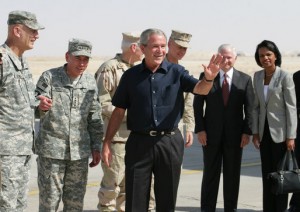Iraq’s Depleted Uranium Threat
Over the past two dozen years, the massive damage that the U.S. has inflicted on Iraq’s population, infrastructure and environment includes the residue from American “deplete uranium” weapons that can cause cancer and other illnesses, writes John LaForge.
By John LaForge
A new report from the Netherlands based on U.S. Air Force firing coördinates shows that the U.S. military fired its armor-piercing munitions ¾ made of waste uranium-238 which is called “depleted uranium” or DU ¾ into civilian areas of Iraq and at Iraqi troops during the 2003 invasion and occupation, defying the U.S. Air Force’s own legal advice that the toxic and radioactive ammunition be used only against hardened targets in compliance with the Laws of War.
The study, “Laid to Waste,” by the Dutch organization PAX found that the lack of legal obligations on U.S.-led militaries in Iraq to help clean-up after using DU weapons has resulted in Iraqi civilians and workers continuing to be exposed to the highly toxic heavy metal years after the war. The health risks posed by the inadequate management of Iraq’s DU contamination are unclear because neither U.S.-led forces nor the Iraqi government have supported health research into civilian DU exposures.
High-risk groups include people living near or working on dozens of Iraqi scrap metal sites where thousands of military vehicles ¾ destroyed in the 1991 and 2003 bombardments ¾ are stored or processed. Waste sites often lack official oversight and in places it has taken more than 10 years to decontaminate military wreckage from residential neighborhoods.
Hundreds of locations that were hit by the weapons, many of which are in populated areas, remain undocumented, and concern among Iraqi civilians over potential health effects from exposure, ingestion and inhalation is widespread.
“To help clean-up we urgently need to know the location and quantities of DU fired,” said the report’s author Wim Zwijnenburg. “The Iraqi government is also in dire need of technical support to help manage the many scrap metal sites where contaminated vehicles are stored.”
The ongoing refusal by the United States to release targeting information continues to hinder the assessment and management of DU in Iraq. The Dutch military contributed a few thousand troops to the Coalition Forces in Iraq, and peacekeepers in Kosovo, and raised alarms over contamination in 2001 and 2006.
A handful of U.S. targeting coordinates held by the Dutch Ministry of Defense, and released after a Freedom of Information Act request, show that U.S. war planes used DU weapons against a far wider range of targets and sites than previously suspected, including Iraqi troops. The U.S. and British governments have long asserted that DU is only for use against armored vehicles. They have often been called “tank busters.”
Depleted Uranium, a by-product of uranium enrichment for reactor fuel and H-bombs, is categorized as an intermediate-level radioactive waste; contaminated rubble and scrap metal are considered low-level radioactive waste. The Dutch study finds that international guidelines for dealing with both kinds of waste ¾ from the International Commission on Radiological Protection ¾ were ignored and that the Iraqi government did not have the technical capacity to safely manage such contamination.
Unlike anti-personnel landmines and other explosive remnants of war, no treaty currently obliges DU users to help clean-up after the war. However, civil radiation protection standards place the responsibility firmly at the foot of the polluters.
Low estimates suggest that at least 440,000 kilograms (488 tons) of DU was fired by the United States in both Gulf Wars in 1991 and 2003. Civilians living near contaminated sites, scrap-yard workers, Iraqi doctors and researchers have repeatedly voiced concerns over the effects of DU on health and the environment.
Hans von Sponeck, a former UN Assistant Secretary General and UN humanitarian coordinator for Iraq, told the Guardian last October, “There is definitive evidence of an alarming rise in birth defects, leukemia, cancer and other carcinogenic diseases in Iraq after the war.”
“In 2001, I saw in Geneva how a World Health Organization mission to conduct on-spot assessments in Basra and southern Iraq, where DU had led to devastating environmental health problems, was aborted under U.S. political pressure,” Sponeck said.
John LaForge is a Co-director of Nukewatch, a nuclear watchdog and environmental justice group in Wisconsin, edits its quarterly newsletter, and writes for PeaceVoice.




Nessun commento:
Posta un commento